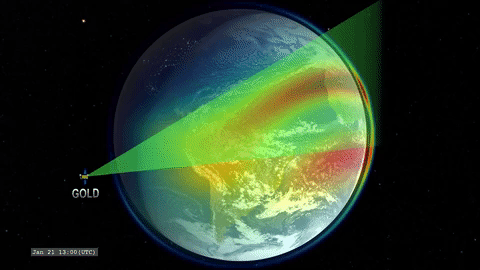NASA's GOLD Mission Powers on for First Time After Eventful Launch

NASA's mission to the boundary between Earth and space switched on for the first time Jan. 28 after its launch a few days earlier, performing a key maneuver before shutting down again for its long journey into high orbit.
The Global-scale Observations of the Limb and Disk (GOLD) mission lifted off as a hosted payload on the SES-14 communications satellite on Jan. 25. Ground control lost contact with the Ariane 5 rocket stage carrying the satellite, but it was successfully deposited in orbit and was able to make contact again with the ground, high enough to still reach its intended geostationary orbit after an extra four weeks of travel.
GOLD switched on for a quick maneuver — the detectors can only work surrounded by nitrogen or a vacuum, so the GOLD team waited until the instrument was in orbit to open the detector doors. After that, the team led GOLD in a few quick tests and shut it down again, less than 20 minutes after turning on, NASA officials said in a statement.
The instrument was originally set to start science operations in mid-October, NASA officials said in a tweet; their partners are working to stick as close as possible to that timeline, they added. Its detectors will let GOLD track the temperatures in the high reaches of Earth's atmosphere, which are influenced by weather on Earth as well as particles and radiation from the sun.
"GOLD will investigate the dynamic intermingling of space and Earth's uppermost atmosphere and seek to understand what drives change in this critical region," NASA officials said in the statement. "Resulting data will improve forecasting models of the space weather events that can impact life on Earth, as well as satellites and astronauts in space."
Email Sarah Lewin at slewin@space.com or follow her @SarahExplains. Follow us @Spacedotcom, Facebook and Google+. Original article on Space.com.
Breaking space news, the latest updates on rocket launches, skywatching events and more!

Sarah Lewin started writing for Space.com in June of 2015 as a Staff Writer and became Associate Editor in 2019 . Her work has been featured by Scientific American, IEEE Spectrum, Quanta Magazine, Wired, The Scientist, Science Friday and WGBH's Inside NOVA. Sarah has an MA from NYU's Science, Health and Environmental Reporting Program and an AB in mathematics from Brown University. When not writing, reading or thinking about space, Sarah enjoys musical theatre and mathematical papercraft. She is currently Assistant News Editor at Scientific American. You can follow her on Twitter @SarahExplains.
